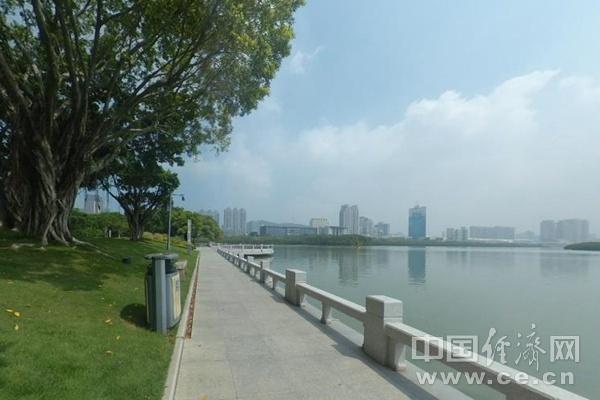The picture shows Xiamen’s Yundang Lake (China Economic Net, Mengya Yun/Photography)
A decade after the release of the “Ten Water Policies,” another significant water management document has been implemented. Recently, the Action Plan for the Protection and Construction of Beautiful Rivers and Lakes (2025-2027) (hereinafter referred to as the “Action Plan”), developed by seven ministries including the Ministry of Ecology and Environment, the National Development and Reform Commission, and the Ministry of Finance, was officially released.
When mentioning beautiful rivers and lakes, we cannot help but recall the picturesque landscapes depicted in poetry, such as “The rivers flow beyond the heavens, the mountains rise within the clouds” and “Mist rises like dream and reverie, waves lap against Yueyang City.” From a development planning perspective, what do beautiful rivers and lakes represent? According to relevant officials from the Ministry of Ecology and Environment explaining the “Action Plan,” beautiful rivers and lakes embody the vision of “clear water and green shores, shallow waters where fish leap.” It implies that water resources, water environment, and aquatic ecosystems across all regions must be effectively protected, greatly enhancing the sense of ecological well-being, happiness, and security among the public, ultimately achieving “harmonious human-water interactions.”
Beautiful rivers and lakes concentrate the achievements and major commitments of beautiful China’s construction within the water ecosystem and environment sector. Since the initiation of the beautiful rivers and lakes project in 2021, implementation has progressed by stages nationwide. Regions like Shenzhen Maozhou River, Xiamen Yundang Lake, Zhejiang’s Thousand-Island Lake, among 94 exceptional cases of beautiful rivers and lakes, have been meticulously chosen.
Of course, the significance of constructing beautiful rivers and lakes lies not only in ecological management but also in economic vitality and people’s wellbeing. For instance, the governance and construction of Shenzhen Maozhou River have provided 15 square kilometers of waterfront space, allocated for small integrated urban complexes, university districts, and high-tech industry zones, attracting over 180 technology enterprises to set up operations. Similarly, Xiamen’s Yundang Lake District has enhanced sewage treatment and flood prevention functions, establishing parks and green spaces along the lake, setting up a nature reserve for white eagles, thus realizing the organic unity of lake district ecological landscape and flood control embankments.
Transforming “good ecological water” into “economic active water,” in turn, nourishes newly formed “ecology” – this is a straightforward philosophical principle. Transforming ecological value requires constant innovation to make the ecological source sustainable and meaningful. Indeed, such experimentation is unfolding in Zhejiang’s Shaoxing and Jinhua, where positive feedback loops of green mountains and rivers are being actively explored. Capital gained from transforming ecological value is reinvested into water ecosystem improvement, aiming to further stimulate societal enthusiasm for loving, preserving, and governing water.
To advance the protection and construction of beautiful rivers and lakes, emphasis on systematic governance is essential. Cross-regional cooperation is a challenge facing river and lake governance. This “Action Plan” suggests promoting cooperative governance of upstream and downstream, left and right banks, and main and tributary streams, expecting that by 2027, key cross-provincial river and lake ecosystems will be effectively protected. Future steps will further promote systematic river basin management, deepen cross-regional cooperation, and explore systematic and multi-dimensional collaborative mechanisms for holistic river basin governance. Promoting the protection and construction of beautiful rivers and lakes also requires adherence to differentiated policies. Thus, the “Action Plan” proposes encouraging localities to include micro water bodies near the people into the scope of protection and construction based on local conditions, clearly defining construction requirements.
Nowadays, the focus of the “Action Plan” is on improving quality and efficiency, addressing not only water pollution management but also issues like aquatic ecological restoration. May 22 is International Biodiversity Day, with this year’s theme “Living Together in Harmony for a Sustainable Future.” Against this backdrop, discussions on the “Protection and Construction of Beautiful Rivers and Lakes” become even more meaningful. Managing river and lake ecosystems is synonymous with protecting biodiversity, effectively preserving humanity itself.
As the public experiences “green view through the window, scenery upon opening the door” anytime and anywhere, with more and more places realizing “harmonious human-water interactions” through “clear water and green shores,” beautiful rivers and lakes will become rivers of happiness for the people. “Poetry and distance” will not remain merely as ideal visions but become tangible aspects of everyday life. (Commentary by China Economic Net, Mengya Yun)


